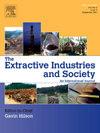Contested masculinities in the exploration phase of the Lihir gold mine, Papua New Guinea
IF 4.3
2区 社会学
Q2 ENVIRONMENTAL STUDIES
Extractive Industries and Society-An International Journal
Pub Date : 2025-01-30
DOI:10.1016/j.exis.2025.101621
引用次数: 0
Abstract
The large gold deposit that is now being mined on the island of Lihir in Papua New Guinea was first discovered in 1982, but the development agreements were not signed until 1995. Between 1985 and 1994, I made several trips to the island in order to assess the future social impacts of the mine and provide advice to various actors on the question of how these impacts could be mitigated. The question of what should be done to mitigate the impact on Lihirian women, or on gender relations in Lihirian society, was one of the questions that had to be addressed. It was already evident that this question was difficult to answer because there was a sort of power struggle going on between the small group of European men who were in charge of the exploration work and a somewhat larger group of Lihirian men who had positioned themselves as representatives of the local community. The first question addressed in this paper is whether this was not just a power struggle between a group of white men and a group of black men in a post-colonial or neocolonial political context, but also a contest between different conceptions of masculinity that were themselves being transformed by the imminent prospect of a large-scale gold mine. The second question is how the evolution of this contest over the course of a decade either broadened or narrowed the scope for Lihirian women to escape the subordinate position that they occupied when the contest began.
在巴布亚新几内亚的利希尔金矿勘探阶段,有争议的男子气概
目前正在巴布亚新几内亚利希尔岛上开采的大型金矿于1982年首次被发现,但开发协议直到1995年才签署。在1985年至1994年期间,我多次前往该岛,以评估该矿未来的社会影响,并就如何减轻这些影响的问题向各行动者提供咨询意见。应该采取什么措施来减轻对利比里亚妇女的影响,或对利比里亚社会性别关系的影响,是必须解决的问题之一。很明显,这个问题很难回答,因为在负责勘探工作的一小群欧洲人与把自己定位为当地社区代表的人数较多的一群利比亚人之间,正在进行一场权力斗争。本文提出的第一个问题是,这是否不仅仅是在后殖民或新殖民政治背景下一群白人男性和一群黑人男性之间的权力斗争,而且也是不同男性气概概念之间的竞争,这些概念本身正在被即将到来的大规模金矿的前景所改变。第二个问题是,这场比赛在过去十年的演变过程中,是如何扩大或缩小了利比里亚妇女摆脱比赛开始时所处的从属地位的范围。
本文章由计算机程序翻译,如有差异,请以英文原文为准。
求助全文
约1分钟内获得全文
求助全文
来源期刊

Extractive Industries and Society-An International Journal
ENVIRONMENTAL STUDIES-
CiteScore
6.60
自引率
19.40%
发文量
135
 求助内容:
求助内容: 应助结果提醒方式:
应助结果提醒方式:


